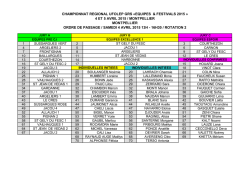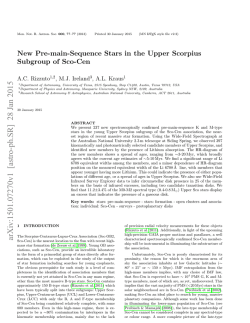
slides
CoRoT 101186644: A transi/ng low-‐ mass dense M-dwarf on an eccentric 20.7-‐day period orbit around a late F-‐star L. Tal-‐Or, T. Mazeh, R. Alonso, F. Bouchy, J. Cabrera, H. J. Deeg, M. Deleuil, S. Faigler, M. Fridlund, G. Hebrard, C. Moutou, A. Santerne, and B. Tingley arXiv:1302.5830 1 CoRoT 101186644: Context ~1 R_Jup object can be a Jovian planet, a BD, or a late M dwarf N (Jovian planets with derived mass and radius) > N (BDs or late M dwarfs with derived mass and radius) Image credit: Chabrier, G. et al. AIP Conf.Proc. 1094 (2009) 102-‐111 arXiv:0810.5085 arXiv:1302.5830: L. Tal-‐Or, T. Mazeh, R. Alonso, F. Bouchy, J. Cabrera, H. J. Deeg, M. Deleuil, S. Faigler, M. Fridlund, G. Hebrard, C. Moutou, A. Santerne, and B. Tingley 2 CoRoT 101186644: The candidate Parameter Value Period (day) 20.68369 (11) Duration (h.) 7.6 Depth (%) 0.96 Ref. Phot FU Roi’s plot CoRoT 101186644 = LRc01_E1_4780 = C4780 Roi’s plot arXiv:1302.5830: L. Tal-‐Or, T. Mazeh, R. Alonso, F. Bouchy, J. Cabrera, H. J. Deeg, M. Deleuil, S. Faigler, M. Fridlund, G. Hebrard, C. Moutou, A. Santerne, and B. Tingley 3 CoRoT 101186644: The star Parameter Value RA (J2000) 19h26m59s.08 Dec (J2000) +00°29’06’’.4 V (mag) 16.05 + 0.07 Ref. ExoDat ExoDat ExoDat Contamina/on level -‐ about 10 % Photometric follow-‐up: on target Top: Image from the Wise Observatory BoWom: Image from CoRoT with the photometric mask arXiv:1302.5830: L. Tal-‐Or, T. Mazeh, R. Alonso, F. Bouchy, J. Cabrera, H. J. Deeg, M. Deleuil, S. Faigler, M. Fridlund, G. Hebrard, C. Moutou, A. Santerne, and B. Tingley 4 CoRoT 101186644: HARPS spectra and RVs Atmospheric parameters Value Method Effective temperature (K) logg (cgs) 6090 + 200 4.4 + 0.2 SME +0.2 + 0.2 SME Metallicity (dex) SME Top image: Nine HARPS spectra co-‐ added (blue) + model (black) arXiv:1302.5830: L. Tal-‐Or, T. Mazeh, R. Alonso, F. Bouchy, J. Cabrera, H. J. Deeg, M. Deleuil, S. Faigler, M. Fridlund, G. Hebrard, C. Moutou, A. Santerne, and B. Tingley 5 CoRoT 101186644: Primary modeling Primary parameters Value Method Mass (M_Sun) Age (Gyr, 2σ) Distance (pc) Atmospheric parameters + YY isochrones Extinction (A_V, mag) 1.2 + 0.2 < 7 1100 +300 / -150 1.1 +0.2 / -0.4 Atmospheric parameters + YY isochrones Broad-band photometry + YY isochrones Broad-band photometry + YY isochrones arXiv:1302.5830: L. Tal-‐Or, T. Mazeh, R. Alonso, F. Bouchy, J. Cabrera, H. J. Deeg, M. Deleuil, S. Faigler, M. Fridlund, G. Hebrard, C. Moutou, A. Santerne, and B. Tingley 6 CoRoT 101186644: MCMC analysis MCMC features: 1. Simultaneous lightcurve and RVs modeling (χ2= χ2lightcurve + χ2RV) 2. 12 free parameters: P, T0, e·∙cosω, e·∙sinω, Js, rt, k, L3, x, up, K, γ 3. Metropolis-‐Has/ngs sampling 4. 1,000,000 accepted steps 5. Lightcurve model: EBOP (Popper & Etzel 1981) arXiv:1302.5830: L. Tal-‐Or, T. Mazeh, R. Alonso, F. Bouchy, J. Cabrera, H. J. Deeg, M. Deleuil, S. Faigler, M. Fridlund, G. Hebrard, C. Moutou, A. Santerne, and B. Tingley 7 CoRoT 101186644: MCMC analysis arXiv:1302.5830: L. Tal-‐Or, T. Mazeh, R. Alonso, F. Bouchy, J. Cabrera, H. J. Deeg, M. Deleuil, S. Faigler, M. Fridlund, G. Hebrard, C. Moutou, A. Santerne, and B. Tingley 8 CoRoT 101186644: MCMC analysis arXiv:1302.5830: L. Tal-‐Or, T. Mazeh, R. Alonso, F. Bouchy, J. Cabrera, H. J. Deeg, M. Deleuil, S. Faigler, M. Fridlund, G. Hebrard, C. Moutou, A. Santerne, and B. Tingley 9 M-‐R rela/on of very low mass stars (VLMS) Star name (by mass) OGLE-TR 123 B SDSS 0857+03 B J1219-39 B OGLE-TR 122 B C4780 B NN Ser B GK Vir B OGLE-TR 106 B GJ 551 HAT-TR-205-013 B SDSS 0138-00 B KIC 1571511 B GJ 699 SDSS 1210+33 B SDSS 1548+40 B RR Cae B 2MASS 0446+19 B arXiv:1302.5830: L. Tal-‐Or, T. Mazeh, R. Alonso, F. Bouchy, J. Cabrera, H. J. Deeg, M. Deleuil, S. Faigler, M. Fridlund, G. Hebrard, C. Moutou, A. Santerne, and B. Tingley 10 Conclusions 1. C4780 B might be the smallest main sequence star ever detected. 2. Further inves/ga/on of the blending frac/on (L3) might reduce the uncertain/es on its radius. 3. The models of VLMS display a large theore/cal spread, caused by differences in age, metallicity, fast rota/on, magne/c ac/vity, strong irradia/on, and clouds (e.g., Lopez-‐Morales 2007; Chabrier et al. 2007; Morales et al. 2010; Bouchy et al. 2011; Burrows et al. 2011; Knigge et al. 2011; Feiden & Chaboyer 2012). 4. No apparent inconsistency between the observed systems and the available theory can be deduced. 5. Complete and homogeneous analysis of low mass M dwarfs that were detected by CoRoT and Kepler might help understanding the astrophysics close to the low end of the main sequence. arXiv:1302.5830: L. Tal-‐Or, T. Mazeh, R. Alonso, F. Bouchy, J. Cabrera, H. J. Deeg, M. Deleuil, S. Faigler, M. Fridlund, G. Hebrard, C. Moutou, A. Santerne, and B. Tingley 11 Conclusions 1. C4780 B might be the smallest main sequence star ever detected. 2. Further inves/ga/on of the blending frac/on (L3) might reduce the uncertain/es on its radius. 3. The models of VLMS display a large theore/cal spread, caused by differences in age, metallicity, fast rota/on, magne/c ac/vity, strong irradia/on, and clouds (e.g., Lopez-‐Morales 2007; Chabrier et al. 2007; Morales et al. 2010; Bouchy et al. 2011; Burrows et al. 2011; Knigge et al. 2011; Feiden & Chaboyer 2012). 4. No apparent inconsistency between the observed systems and the available theory can be deduced. 5. Complete and homogeneous analysis of low mass M dwarfs that were detected by CoRoT and Kepler might enhance our understanding of the astrophysics close to the low end of the main sequence. arXiv:1302.5830: L. Tal-‐Or, T. Mazeh, R. Alonso, F. Bouchy, J. Cabrera, H. J. Deeg, M. Deleuil, S. Faigler, M. Fridlund, G. Hebrard, C. Moutou, A. Santerne, and B. Tingley 12
© Copyright 2025

